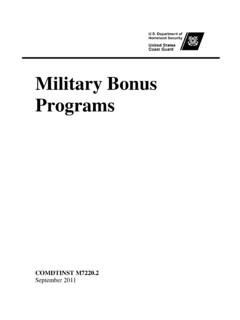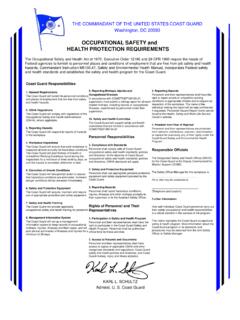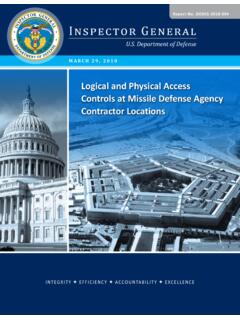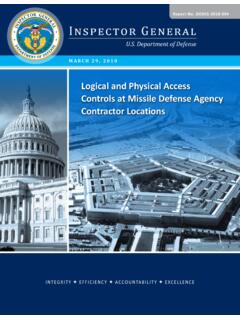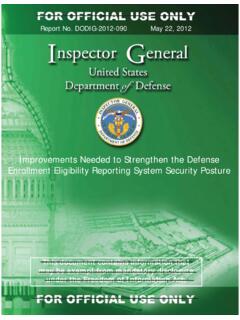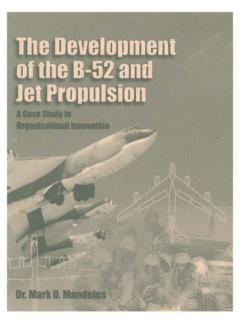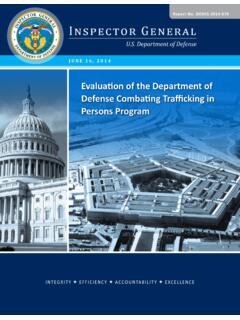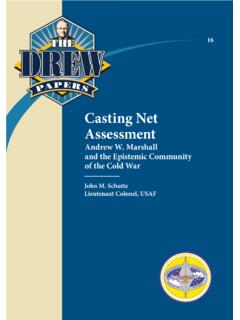Transcription of Department of Defense Indo-Pacific Strategy Report 2019
1 This page left intentionally blank THE DEPARMENT OF Defense Indo-Pacific Strategy Report Preparedness, Partnerships, and Promoting a Networked Region June 1, 2019 The estimated cost of this Report or study for the Department of Defense is approximately $128,000 for the 2019 Fiscal Year. This includes $18,000 in expenses and $110,000 in DoD labor. Generated on 2019 June01 RefID: 0-1C9F36A MESSAGE FROM THE SECRETARY OF Defense he Indo-Pacific is the Department of Defense s priority theater. The United States is a pacific nation; we are linked to our Indo-Pacific neighbors through unbreakable bonds of shared history, culture, commerce, and values. We have an enduring commitment to uphold a free and open Indo-Pacific in which all nations, large and small, are secure in their sovereignty and able to pursue economic growth consistent with accepted international rules, norms, and principles of fair competition.
2 The continuity of our shared strategic vision is uninterrupted despite an increasingly complex security environment. Inter-state strategic competition, defined by geopolitical rivalry between free and repressive world order visions, is the primary concern for national security. In particular, the People s Republic of China, under the leadership of the Chinese Communist Party, seeks to reorder the region to its advantage by leveraging military modernization, influence operations, and predatory economics to coerce other nations. In contrast, the Department of Defense supports choices that promote long-term peace and prosperity for all in the Indo-Pacific . We will not accept policies or actions that threaten or undermine the rules-based international order an order that benefits all nations. We are committed to defending and enhancing these shared values. The National Security Strategy and the National Defense Strategy articulate our vision to compete, deter, and win in this environment.
3 Achieving this vision requires combining a more lethal Joint Force with a more robust constellation of allies and partners. Increased investments in these imperatives will sustain American influence in the region to ensure favorable balances of power and safeguard the free and open international order. This 2019 Department of Defense Indo-Pacific Strategy Report (IPSR) affirms the enduring commitment to stability and prosperity in the region through the pursuit of preparedness, partnerships, and the promotion of a networked region. T Preparedness Achieving peace through strength and employing effective deterrence requires a Joint Force that is prepared to win any conflict from its onset. The Department , alongside our allies and partners, will ensure our combat-credible forces are forward-postured in the region. Furthermore, the Joint Force will prioritize investments that ensure lethality against high-end adversaries.
4 Partnerships Our unique network of allies and partners is a force multiplier to achieve peace, deterrence, and interoperable warfighting capability. The Department is reinforcing its commitment to established alliances and partnerships, while also expanding and deepening relationships with new partners who share our respect for sovereignty, fair and reciprocal trade, and the rule of law. Promotion of a Networked Region The Department is strengthening and evolving alliances and partnerships into a networked security architecture to uphold the international rules-based order. The Department also continues to cultivate intra-Asian security relationships capable of deterring aggression, maintaining stability, and ensuring free access to common domains. Advancing this Indo-Pacific vision requires an integrated effort that recognizes the critical linkages between economics, governance, and security all fundamental components that shape the region s competitive landscape.
5 The Department of Defense , in partnership with other Government Departments and Agencies, regional institutions, and regional allies and partners, will continue to diligently uphold a rules-based order that ensures peace and prosperity for all. Patrick M. Shanahan Acting Secretary of Defense This page left intentionally blank Indo- pacific Strategy Report Contents 1. Introduction .. 1 America s Historic Ties to the Indo-Pacific .. 2 Vision and Principles for a Free and Open Indo-Pacific .. 3 2. Indo-Pacific Strategic Landscape: Trends and Challenges .. 7 The People s Republic of China as a Revisionist 7 Russia as a Revitalized Malign Actor .. 11 The Democratic People s Republic of Korea as a Rogue State .. 12 Prevalence of Transnational Challenges .. 13 3. National Interests and Defense Strategy .. 15 National Interests .. 15 National Defense Strategy .. 16 4. Sustaining Influence to Achieve Regional Objectives.
6 17 Line of Effort 1: Preparedness .. 17 Line of Effort 2: Partnerships .. 21 Line of Effort 3: Promoting a Networked Region .. 44 Conclusion .. 53 Acronyms .. 55 Indo- pacific Strategy Report This page left intentionally blank Indo- pacific Strategy Report 1 1. Introduction he Indo-Pacific is the single most consequential region for America s future. Spanning a vast stretch of the globe from the west coast of the United States to the western shores of India, the region is home to the world s most populous state, most populous democracy, and largest Muslim-majority state, and includes over half of the earth s population. Among the 10 largest standing armies in the world, 7 reside in the Indo-Pacific ; and 6 countries in the region possess nuclear weapons. Nine of the world s 10 busiest seaports are in the region, and 60 percent of global maritime trade transits through Asia, with roughly one-third of global shipping passing through the South China Sea alone.
7 The United States is a pacific nation and has five pacific states: Hawaii, California, Washington, Oregon, and Alaska, as well as pacific territories on both sides of the International Date Line, including: Guam, American Samoa, T The story of the Indo-Pacific in recent decades is the story of what is possible when people take ownership of their region has emerged as a beautiful constellation of nations, each its own bright star, satellites to none. - President Donald J. Trump, speech at the APEC CEO Summit, November 10, 2017 Indo- pacific Strategy Report 2 Wake Island, and the Commonwealth of Northern Mariana Islands (CNMI). American businesses have traded in Asia since the 18th century, and today, within the Asia- pacific Economic Cooperation (APEC), America s annual two-way trade with the region is $ trillion, with foreign direct investment of $ trillion in the region more than China s, Japan s, and South Korea s combined.
8 The Indo-Pacific contributes two-thirds of global growth in gross domestic product (GDP) and accounts for 60 percent of global GDP. This region includes the world s largest economies the United States, China, and Japan and six of the world s fastest growing economies India, Cambodia, Laos, Burma, Nepal, and the Philippines. A quarter of exports go to the Indo-Pacific , and exports to China and India have more than doubled over the past decade. This is made possible by free and open trade routes through the air, sea, land, space, and cyber commons that form the current global system. America s Historic Ties to the Indo-Pacific The United States is a pacific nation. Our ties to the Indo-Pacific are forged by history, and our future is inextricably linked. We have contributed both blood and treasure to sustain the freedoms, openness, and opportunity of this region. Our presence secures the vital sea lanes of the Indo-Pacific that underpin global commerce and prosperity.
9 Our leaders, diplomats, military forces, and businesses helped frame and strengthen the international system of clear and transparent rules; peaceful resolution of disputes; and the rule of law that has been vital to the region s relative security and growing prosperity. The past, present, and future of the United States are interwoven with the Indo-Pacific . Our engagement in the Indo-Pacific dates back more than two centuries, based on the pursuit of the shared prosperity that comes from fair and reciprocal trade, open commerce, and freedom of navigation. In 1784, within months of signing the Treaty of Paris, the United States sent a trading ship, the EMPRESS OF CHINA to inaugurate commercial ties with China. In 1804, President Thomas Jefferson sent the explorers Lewis and Clark on an expedition to our pacific Coast, which Jefferson recognized as the gateway for increased trade and commerce.
10 By 1817, Congress approved the first full-time pacific deployment of a warship. In the early 19th century, we began our relationship with the Kingdom of Thailand and thereafter negotiated to open Japan to global trade in the 1850s. Starting in the Indo-Pacific , our priority theater, we continue to pursue many belts and many roads by keeping our decades-old alliances strong and fostering growing partnerships. - Acting Secretary of Defense Patrick M. Shanahan, testimony to the Senate Armed Services Committee, March 14, 2019 Indo- pacific Strategy Report 3 At the close of the 19th century, the United States established an Open Door policy towards China, promoting equal opportunity for trade and commerce in China, and respect for China s sovereignty. In the 20th century, the United States expanded its role in the region as we confronted imperialism and fascism and held the line against communism during the Cold War.
